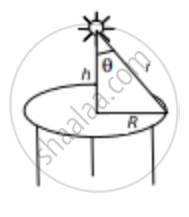Advertisements
Advertisements
प्रश्न
A student is studying a book placed near the edge of a circular table of radius R. A point source of light is suspended directly above the centre of the table. What should be the height of the source above the table so as to produce maximum illuminance at the position of the book?
उत्तर

Let the height of the source be h and the luminous intensity in the normal direction be I0.
So, illuminance on the book (E) is given by,
\[E = \frac{I_0 \cos\theta}{r^2}\]
From the figure we get
Cosθ = \[\frac{h}{r}\]
On substituting the value of Cosθ, we get
\[E = \frac{I_0 h}{r^3}\]
But r = \[\sqrt{R^2 + h^2}\]
\[\therefore E=\frac{I_0 h}{\left( r^2 + h^2 \right)^\frac{3}{2}}\]
For maximum illuminance,
\[\frac{dE}{dH} = 0\]
\[\frac{dE}{dH} = \frac{I_0 \left[ \left( R^2 + h^2 \right)^\frac{3}{2} - \frac{3}{2}h \times \left( R^2 + h^2 \right)^\frac{1}{2} \times 2h \right]}{\left( R^2 + h^2 \right)^3} = 0\]
\[\Rightarrow \left( R^2 + h^2 \right)^\frac{1}{2} \left[ R^2 + h^2 - 3 h^2 \right] = 0\]
\[ \Rightarrow R^2 - 2 h^2 = 0\]
\[ \Rightarrow h = \frac{R}{\sqrt{2}}\]
APPEARS IN
संबंधित प्रश्न
What is the luminous flux of a source emitting radio waves?
Light is incident normally on a small plane surface. If the surface is rotated by an angle of 30° about the incident light, does the illuminance of the surface increase, decreases or remain same? Does your answer change if the light did not fall normally on the surface?
Why is the luminous efficiency small for a filament bulb as compared to a mercury vapour lamp?
The yellow colour has a greater luminous efficiency as compared to the other colours. Can we increase the illuminating power of a white light source by putting a yellow plastic paper around this source?
The one parameter that determines the brightness of a light source sensed by an eye is ____________ .
An electric bulb is hanging over a table at a height of 1 m above it. The illuminance on the table directly below the bulb is 40 lux. The illuminance at a point on the table 1 m away from the first point will be about ___________ .
A photographic plate is placed directly in front of a small diffused source in the shape of a circular disc. It takes 12s to get a good exposure. If the source is rotated by 60° about one of its diameter, the time needed to get the same exposure will be ___________ .
A point source of light moves in a straight line parallel to a plane table. Consider a small portion of the table directly below the line of movement of the source. The illuminance at this portion varies with its distance r from the source as ___________ .
Mark the correct options.
(a) The luminous efficiency of a monochromatic source is always greater than that of a white light source of same power.
(b) The luminous efficiency of a monochromatic source of wavelength 555 nm is always greater than that of a white light source of same power.
(c) The illuminating power of a monochromatic source of wavelength 555 nm is always greater than that of a white light source of same power.
(d) The illuminating power of a monochromatic source is always greater than that of a white light source of same power.
The relative luminosity of wavelength 600 nm is 0.6. Find the radiant flux of 600 nm needed to produce the same brightness sensation as produced by 120 W of radiant flux at 555 nm.
A source emits light of wavelengths 555 nm and 600 nm. The radiant flux of the 555 nm part is 40 W and of the 600 nm part is 30 W. The relative luminosity at 600 nm is 0.6. Find (a) the total radiant flux, (b) the total luminous flux, (c) the luminous efficiency.
A light source emits monochromatic light of 555 nwavelengthm. The source consumes 100 W of electric power and emits 35 W of radiant flux. Calculate the overall luminous efficiency.
A source emits 31.4 W of radiant flux distributed uniformly in all directions. The luminous efficiency is 60 lumen watt−1. What is the luminous intensity of the source?
A point source emitting 628 lumen of luminous flux uniformly in all directions is placed at the origin. Calculate the illuminance on a small area placed at (1.0 m, 0, 0) in such a way that the normal to the area makes an angle of 37° with the X-axis.
Two light sources of intensities 8 cd and 12 cd are placed on the same side of a photometer screen at a distance of 40 cm from it. Where should a 80 cd source be placed to balance the illuminance?
Light rays from a point object ______.
